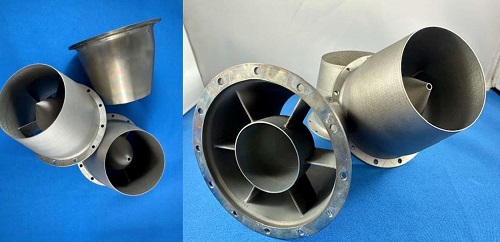Aurora Labs (A3D), a manufacturer of 3D metal printers, powders, and digital parts, has progressed its product development of a 200N Class micro gas turbine – a combustion engine at the center of a small propulsion system or power plant that can convert natural gas or other liquid fuels to mechanical energy for requirements in applications including unmanned aerial vehicles or instant power generation. The current model will be available on the market as early as next month, with capabilities for lightweight propulsion systems in a broad range of markets. In parallel, the development of a 400N Class model is progressing.
“3D metal printing has worked to its strength in accelerating the product prototyping process of A3D’s sovereign turbine engine. The team has manufactured an advanced product in under 4 months. The turbine engine design and printing has successfully met benchmarks for laboratory prototype testing, which is at the cutting edge of high energy 3D metal printing of components. Testing will now move to the field where the engine can be fitted to a remotely piloted airframe,” said Rebekah Letheby, CEO of Aurora Labs. “We have an excellent level of interest for A3D’s printed engines which also have application not only to unmanned aerial vehicles, but also instant power generation. It is our goal to have a cutting-edge piece of technology to sell to the sizeable defense and aerospace markets.”

Turbine development
In the development of the prototype, A3D has set about meeting market-established benchmarks for its 200N Class gas turbine engine. The required thrust, air intake efficiencies, engine weight, and fuel consumption constraints have been met, and the company has further scope for improvement through unique generative design changes – suited for 3D printing.
The engine operates and compares in function and performance requirements to comparable engines built by traditional manufacturing methods. The advantage of the A3D engine is the fact that it consists of fewer complex parts – resulting in a fast and reliable assembly process, without compromising on performance. A3D has the 3D printing machines and expertise to carry out production runs of the engine, onshore, in Australia.
The efficiency and weight of turbines are key areas of focus in A3D’s testing. These two aspects are addressed in their turbine model by selecting individual parts that can be made lighter through design, as well as choosing metal materials that ensure efficient performance and allow for a reduction in overall mass. A lighter engine benefits aircraft by improving fuel efficiency. The design team also focuses on ensuring that parts of the A3D turbine are combined and printed as a single assembly. While this is not currently possible for all parts, reducing the number of parts has optimized the time required to assemble the engine and improved the ease of assembly by using fewer parts. In one section of the engine, A3D has managed to amalgamate 18 parts into just one printed part, achieving a 20% weight reduction compared to traditional engines of the same class.
The metal materials selected for the 3D printed parts show the required mechanical strength. Testing has shown that the printed interior components can perform with the required metallurgy withstanding the stress and high temperature that the metal material is subject to during the firing of the engine. The printed material is comparable to conventional metal materials which gives assurance to users that the end quality of the metal product is reliable and repeatable with the A3D printing method.
Fuel type is also of consideration, the company’s turbine being able to run on Jet-A1, kerosene, and diesel fuels – enabling the end user to use the turbine in many different environments, where specific fuel types may not be readily available.

Defense and aerospace
Data from the current testing round will be supplied to several prospective customers who have requirements for gas turbine systems in various applications, including propulsion of unmanned aerial vehicles or instant power generation.
The supply of the engine is of particular importance in supporting Australian-based defense capabilities, and fits well with the pillars of the Australian Defence Review, 2023.
Aurora Labs is working with several customers who have seen the capabilities of the gas turbine engine whilst in testing. In conjunction with testing of the 200N Class model, the company is fast-tracking the design and build of the larger 400N Class gas turbine model which will further enhance the market opportunities for large-scale applications in the unmanned aerial vehicle sector where small turbines can be utilized as propulsion systems.
3D printed metal parts in the defense and aerospace industries will continue to be promoted to both large and small enterprises seeking innovative solutions, particularly with targeted geometries that excel in 3D metal printing.
The company is also continuing to work towards delivering the first AL250 printer.
Join us at TCT Asia, connect with industry innovators as you explore the entire AM ecosystem including design, materials, hardware, software, post-processing, and quality. 10,000+ professionals will unite to hear about the latest trends, explore the latest immersive AM technologies and find solutions to their AM challenges.

TCT ASIA 2024
Tuesday 7th May 09:00 - 17:30
Wednesday 8th May 09:00 - 17:30
Thursday 9th May 09:00 - 15:00
NECC(Shanghai)7.1&8.1H